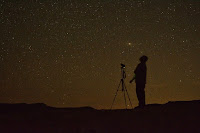Introduction and Monthly Reminders
January has been a cold and stormy month so far this year. The good news, however, is that with the storms, the inversion has been kept away for the most part. This has allowed me to see Venus in the western sky, Jupiter near the zenith, and Mars in the eastern sky after sunset. Orion also shined brightly and is always a treat to catch in the night sky. I could still spot Mars in the western sky during the early morning hours. Arcturus was high in the southern sky, and Vega was closer to the Rocky Mountains during my drive to work in the morning.
Many of these sights will continue through the end of the month for observers interested in catching these planets and bright stars. Mars has just reached opposition, making it a great time to view this planet. Even without a telescope, it will shine brightly and be easily picked out in the eastern sky after sunset. On the 19th, the planetary conjunction between Venus and Saturn will occur. A pair of binoculars should separate the two planets, making them visible in a single field of view. A low-power eyepiece in a telescope will reveal the rings of Saturn and the phase of Venus in a single field of view.
Guide to the 2025 Night Sky
A new year is here, and there are many great stargazing opportunities to be aware of. This year, the Sun will reach its solar maximum, meaning it will be even more active than it was the last few years. Last year, Utahns were able to see the Northern Lights, and hopefully, with the solar maximum reaching its peak this year, many more opportunities will present themselves.
The winter sky contains many significant deep sky objects and some of the brightest stars and most recognizable constellations. The winter season officially begins in December and will continue through the March Equinox, which falls on the 20th of March this year. Between now and then, observers should focus on Orion, Taurus, and Gemini. The Orion Nebula (M42) can be found just below the belt stars of Orion. This nebula can be seen with the unaided eye from a dark sky location, but of course, a telescope will reveal much more detail. Using Orion's belt stars, an observer can locate the Pleiades (M45), the brightest star cluster in the sky. This cluster can be seen with the unaided eye, but again, visual aiding devices will significantly enhance the view. I recommend a pair of binoculars or telescopes with a low-power eyepiece. During March, observers can participate in a Messier Marathon, a marathon of locating all 110 Messier objects in a single night. The best time to join the Messier Marathon falls on the first of March this year. At this time, the Moon will be out of the sky, and most, if not all, of the Messier objects will be visible. On March 14th, Utahns will be treated to a Total Lunar Eclipse.
The Spring months are when temperatures finally start to rise, and more astronomers are willing to be outdoors. This includes the end of March, April, May, and most of June. This is a great time to view the Beehive Cluster (M44), one of my favorite open star clusters. Many galaxies can also be seen in the Virgo and Coma Berenices constellations. Optical aid is required! The Lyrid meteor shower will occur on April 22nd, perhaps the first major meteor shower that many observers will be interested in due to the warm weather.
The Summer months probably get the most attention from astronomers due to the warm weather and kids being out of school. This includes the end of June through most of September. Many individuals are able to go camping to get away from most sources of light pollution, which dramatically enhances the stargazing experience. The Summer Triangle will be high overhead and is full of deep-sky objects. Many of my favorite deep-sky objects are best viewed during this time, including the Hercules Cluster (M13), the Ring Nebula (M57), and the Wild Duck Cluster (M11). The summer months also represent the best time to view the Milky Way band. There will be a planetary conjunction with Venus and Jupiter on August 12th. The Perseid Meteor Shower will also peak on the 12th, making this an excellent time for observers to be looking up! Saturn will reach opposition on the 21st of September, the day before the September Equinox.
The Autumn months will bring several notable meteor showers, including the Orionids on October 21st, the Leonids on November 17, and the Geminids on December 14th. This time of year is also the best time to view the Andromeda Galaxy (M31), the Double Cluster in Perseus (NGC 896 and NGC 884), and Albireo, the best double star to view. This double star consists of a blue and yellow star, which contrast very well. A telescope is required to separate this pair of stars.
As observers learned in previous years, including 2024, comets are unpredictable and may appear anytime. I will keep my readers as up-to-date as possible if any such comet is discovered! Now, get outside and enjoy the wonders of the universe!


No comments:
Post a Comment